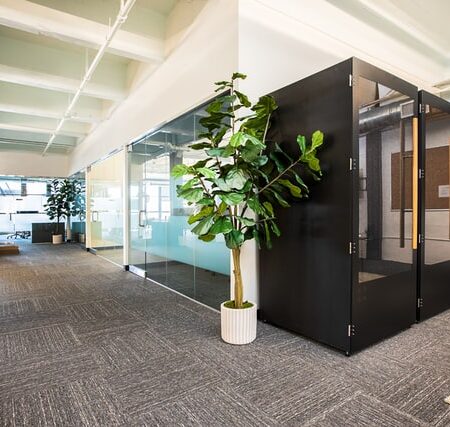There is no doubt that hardwood flooring is among the most luxurious and desirable options. But its cost and maintenance requirements match its looks. And that is where engineered hardwood steps in. Find out what is engineered hardwood and discover its many varieties and features before flooring installation
What is engineered hardwood flooring made of?
The key difference between hardwood and engineered hardwood is that instead of being a solid wood plank, engineered hardwood has a composite core with a decorative layer on top. What engineered hardwood flooring is most admired for is its strong resistance to deformation. The arrangement of each layer varies from layer to layer. As a result, engineered hardwood is less likely to budge with time or as a result of moisture.
Is engineered hardwood durable?
It highly depends on what engineered wood flooring you choose, but in general, it is fairly sturdy. Your wood flooring will serve you well for decades if you take proper care of it. It can also cope better with moisture and be more forgiving to humidity and spills. Its increased resistance to temperature changes helps it work well with heated floors.
What it lacks, though, is the refurbishing potential. The decorative veneer is rather thin, meaning the times you can sand it is limited. And even though engineered hardwood is durable, minor wear and tear will appear over the years.
What are the types of engineered hardwood flooring?
When it comes to types, the main question is what the engineered floor’s core is constructed of. You can find floors with different assembly types, top layer styles, and other distinct differences. But the composition of the core layer is decisive for the flooring price and properties. There are three main options: plywood, HDF, and SPF.
Plywood Construction
With this type, several layers of plywood are pressed together with adhesive. It forms the basis, which is then covered with lamella. Plywood is the most common material for engineered hardwood. Variability in a number of layers allows for flexible pricing.
HDF Core
If you want maximum durability, a high-density fiberboard is your choice. It is made of pressed-together sawdust and other wood leftovers. The resulting material is very dense and fairly water-resistant. Floors with this core are often advised for bathrooms and other humid rooms. In addition, HDF allows the introduction of click-together parts to the planks, making the assembly much easier.
SPF
The acronym stands for Spruce, Pine, and Fir trees. Under the lamella, they act as the hardwood’s core components. They are put together and positioned so that they are parallel to the lamella above. The boards become stronger as a result and are less likely to contract and expand in response to temperature fluctuations.
Enhanced durability and all-natural materials help increase the popularity of engineered hardwood with this core type. A tongue-and-groove constitution of the layers helps them fit perfectly, resulting in smooth, seamless flooring.
What is the best thickness for engineered wood flooring?
The answer to what is the best thickness for engineered wood flooring is very simple — the thicker, the better. The thickness of an engineered hardwood floor determines how well it can survive temperature changes, moisture, and mechanical damage. Thinner options may seem attractive as they are, on average, four times cheaper. But deciding to save on the purchase may result in expensive renovations later. Floors with thin decorative layers and protective coatings are easily damaged and may need to be restored really fast.
In terms of thickness, the majority of hardware stores can present you with three options. The first is a three-ply, with ¾” overall thickness and 0,03-0,06 inches top layer. This may be good enough for a not-too-active household or seldom-used rooms.
The next is a five-ply. It has five layers of protective coating, which is double in thickness compared to the previous one. The overall thickness is, however, reduced to ½”, but the amount of protection makes up for it.
And, finally, nine-ply, the thickest and most durable one. Its overall thickness is the same as three-ply’s, but the protective layer has 0,21 inches. If you know there will be a lot of activity in your home or want your flooring to last as long as possible, this one is your choice.
As you see, the answer to what is the most durable engineered hardwood flooring is very intuitive — EDF core and as many layers as possible. It doesn’t, however, ensure 100% safety to install it in an area with extreme moisture. Always consult with professionals before making a decision to go for hardwood in a certain room.
Where can you use engineered wood flooring?
Engineered hardwood flooring has countless advantages and can be used in any room where hardwood can be used. In aesthetical terms, they are practically indistinguishable. And a large palette of available decorative layers will help you find a tone that fits the style of your home.
And because of how durable engineered hardwood is, it will also work with rooms where you wouldn’t normally put wooden floors. Those include bathrooms, basements, hallways, etc. But note that even though it is sturdier, this doesn’t mean it is invincible. Consult with professionals before deciding to use engineered hardwood in any room.
Conclusion
Engineered hardwood has a composite core with a decorative veneer on top of it. The reduced amount of expensive wood used to produce it makes it cheaper than regular hardwood flooring. Engineered hardwood is sturdier and more resistant to water as well. Its price and properties are determined by many factors, including core materials and thickness. Engineered wood will make for beautiful flooring in the living room and is also a fitting material for more humid areas.
Contact us today for a free consultation and estimate.


